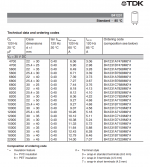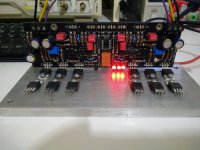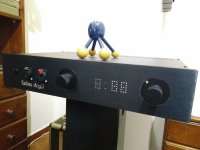When we did the first test with BIB, we then also concluded that it was more musical than the SMPS one but was not that obvious (we have to listen carefully to spot the differences) and was not worth the hassle (at least I wouldn't bothered). With no overheating problems, having more time listening to it, now I would say that the other PSUs didn't change the character of the DAC (the upfront, not much depth presentation of it) but they had impact on many characteristics that make a device pleasing or not.
I do like harmonic-rich sound but I don't like the presentation of this DAC and L-apapter / BIB made it at least listenable.
The change to a more 'meatier' sound I described for L-adapter powering Bufallo 9028 wasn't heard this time most probably because ADI2 already has that sound so it's there in all PSUs
I think the main use for L-adapter is for heavier, not stable, loads so I'm gonna focus in powering such devices (Tinker, PC)
The ADI-2 has that rock studio kind of core presentation I would dare say. Its versatility and metering are great besides preference nonetheless.
Salas how many voltage do you think you can get with 6.3V input on the output of the L-adapter?
In your case with the 12V Tx you measured 7.5V Vin-Vout difference for 6.3V output. 12*1.41=16.92 but 7.5+6.3=13.8 so 16.92-13.8=3.12V losses in diodes VF and caps ripple voltage.
6.3V Tx * 1.41 would give 8.88-3.12=5.76V i.e. too low. Won't work, only enough for say a 3.3V digital application, get a 9V Tx. That one would give 9*1.41=12.69-3.12=9.57 which is 3.27V more than 6.3V heaters, thus a very good margin for the L-Adapter's main pass transistor. Enough voltage across it with half the dissipation from now that you got 7.5V across it.
6.3V Tx * 1.41 would give 8.88-3.12=5.76V i.e. too low. Won't work, only enough for say a 3.3V digital application, get a 9V Tx. That one would give 9*1.41=12.69-3.12=9.57 which is 3.27V more than 6.3V heaters, thus a very good margin for the L-Adapter's main pass transistor. Enough voltage across it with half the dissipation from now that you got 7.5V across it.
Thank you Salas! So simple when you explain 🙂 9V transformer is coming my way. I will report new operating temperatures.
And maybe a comparison between old PS-21 and new heaters PSU in case there are any SQ clues beyond less hiss that you noticed. Because enough people have the Aikido pre and they maybe are interested to know if the heaters supply plays a role.
Those are 4A rated diodes, they will hold against the charge transients with up to 2x6800uF capacitors and 30-50VA transfo but if you're to use 2x10000uF and bigger transfo for higher loads in the future, put 8A rated diodes or more. If to use 4A diodes use a 4A slow blow F1 fuse also.
Thank you. Rpi takes emax current of 1.5-2Amp.
In that case 2x 6800uF will be sufficient? How about using 2x4700 uF for loads up to 1Amp?
In that case 2x 6800uF will be sufficient? How about using 2x4700 uF for loads up to 1Amp?
Yes they will be sufficient for the Rpi. Their combined ripple current ability is very capable. 2x4700uF are no slouch either especially for 1 Ampere.
Rpi is not a demanding load for the L-Adapter. For knowing more on rectification & filtering dynamics vs loading given the wider range of applications possible with this PSU read below:
Things are relevant to some factors. I was able to power a 55W peaking iron with just 2x4700uF for instance. But I had 18V good quality transformer rectified to 27VDC unloaded (that Tx was doing higher than its nominal). With 18VDC output setting in the L-A there was much Vin-Vout voltage space available to be partially eaten by the AC ripple voltage created when with not so high reservoir capacitance under high power demands.
What we look for is not to use too high capacitance when the loading targets cause acceptable ripple voltage, still allowing for no less than 2.5V Vin-Vout margin. So not to have great inrush currents and bridge diodes transient strain for no reason. Not too high Vin-Vout under load also. Because it creates more dissipation. But not to have high ripple voltage to be filtered by the circuit either. Say no more than 1.5V peak to peak in average. Its a juggling act if we want to sit at a most efficient point all things considered. Factors are many but we can roughly predict ripple voltage figures from just a few. The ballpark formula is:
Vpk-pk ripple= I_Load /2*f *C (use Volt Amp Hz Farad)
Don't forget f=50Hz or 60Hz (EUR USA). Also C=C3+C4 in our circuit. For example when C3+C4=20mF plug 0.02 Farad.
A true RMS multimeter can read ripple's AC RMS value when you don't have an oscilloscope to see peak to peak. Red probe on fuse's bottom end (the one near the main sink) and black on the 0V output. Multiply the reading by 3.3 for pk-pk because the waveform's shape is not a perfect sawtooth (x3.46). The actual Vpp result can even prove better than what the ballpark formula predicted.
When subtracting two diodes Vf loss and Vripple pk-pk for a given max load current and the reservoir capacitors used, we want our transfo to provide for all that plus 2.5V Vin-Vout DC left for the pass transistor to work well in worst case.
edit: Revised the post to more detail.
Rpi is not a demanding load for the L-Adapter. For knowing more on rectification & filtering dynamics vs loading given the wider range of applications possible with this PSU read below:
Things are relevant to some factors. I was able to power a 55W peaking iron with just 2x4700uF for instance. But I had 18V good quality transformer rectified to 27VDC unloaded (that Tx was doing higher than its nominal). With 18VDC output setting in the L-A there was much Vin-Vout voltage space available to be partially eaten by the AC ripple voltage created when with not so high reservoir capacitance under high power demands.
What we look for is not to use too high capacitance when the loading targets cause acceptable ripple voltage, still allowing for no less than 2.5V Vin-Vout margin. So not to have great inrush currents and bridge diodes transient strain for no reason. Not too high Vin-Vout under load also. Because it creates more dissipation. But not to have high ripple voltage to be filtered by the circuit either. Say no more than 1.5V peak to peak in average. Its a juggling act if we want to sit at a most efficient point all things considered. Factors are many but we can roughly predict ripple voltage figures from just a few. The ballpark formula is:
Vpk-pk ripple= I_Load /2*f *C (use Volt Amp Hz Farad)
Don't forget f=50Hz or 60Hz (EUR USA). Also C=C3+C4 in our circuit. For example when C3+C4=20mF plug 0.02 Farad.
A true RMS multimeter can read ripple's AC RMS value when you don't have an oscilloscope to see peak to peak. Red probe on fuse's bottom end (the one near the main sink) and black on the 0V output. Multiply the reading by 3.3 for pk-pk because the waveform's shape is not a perfect sawtooth (x3.46). The actual Vpp result can even prove better than what the ballpark formula predicted.
When subtracting two diodes Vf loss and Vripple pk-pk for a given max load current and the reservoir capacitors used, we want our transfo to provide for all that plus 2.5V Vin-Vout DC left for the pass transistor to work well in worst case.
edit: Revised the post to more detail.
So larger capacitance to avoid too high ripple with higher current load (and AFAIU for "cruising current load", peak current is something else), is the capacitor current ripple spec of any interest? I understand that //ing 2 caps helps here, is it made on purpose? Or maybe I answered myself and their ripple current feeds the peak demand?
So larger capacitance to avoid too high ripple with higher current load (and AFAIU for "cruising current load", peak current is something else), is the capacitor current ripple spec of any interest? I understand that //ing 2 caps helps here, is it made on purpose? Or maybe I answered myself and their ripple current feeds the peak demand?
The capacitors ripple current spec should allow for the max AC current needed in the rectification recharge cycle to replenish them for a heavy load. Two capacitors are doubling that when their size and uF are kept smaller than having a comparable IAC max rating from a larger single.
See an example datasheet. Even 2x6800uF have bit more combined ripple current than the 22000uF alone. With 2x10000uF almost 33% more.
Attachments
So I did some more listening and comparison against PS-21. I have two preamps in my main system now dual mono DCG3 with UBIB PSU and Aikido. DCG3 is absolutely amazing when it comes do details , transparency and huge: wide, tall and deep sound stage. The Aikido with PS-21 gives you more richness in the tone, for lack of better words, but a bit less details and transparency. Not bad, just a bit less 'holographic'. Where it loses big time is in soundstage department, it is less wide and tall. Quite deep behind the speaker line. When I changed PS-21 heater supplies for two L-adapters, I can tell from some extensive audition, the preamp gained in clarity and transparency keeping same tonal richness. I like it better fir sure. I am looking forward to the GB to get SSHV2 and see how it affects the sound. Also I got two more L-boards, just in case as I really like the idea and implementation 🙂
Good info and nice results. Thanks. I will be helping a friend finish a balanced XLR doubled up DCG3 soon. Including a motorized Khozmo 4X pot and remote control. Combining a 2X500W @ 4Ω Cubed line Bryston amp and PMC IB2i transmission line speakers. He has done the efforts on the chassis department but he is not confident about doing the electronics alone.
Attachments
Great job from you and your friend Nick. That reminds me that I have to finish my balanced DCG3 project.
Back to L-adapter it seems all right powering Tinker (I'm writing this message via it). With starting voltage 5.074 VDC the lowest voltage I've got so far is 4.967 VDC while playing youtube 720p video (never missing a frame).
It must draw quite current because with normal micro USB cable it won't start and with the one supplied with Due (bulkier) I faced some sudden power downs. I'll measure watt consumption later on.
The real test will be when I setup Volumio and do a real audio test with Ian's isolator and FIFO.
Back to L-adapter it seems all right powering Tinker (I'm writing this message via it). With starting voltage 5.074 VDC the lowest voltage I've got so far is 4.967 VDC while playing youtube 720p video (never missing a frame).
It must draw quite current because with normal micro USB cable it won't start and with the one supplied with Due (bulkier) I faced some sudden power downs. I'll measure watt consumption later on.
The real test will be when I setup Volumio and do a real audio test with Ian's isolator and FIFO.
So you give extra refund warranty on any fried RPi/TB powered via GPIO? Pretty confident in the L-Adapter =)
Note: I am kidding, guys don't fry your computers!!!
Note: I am kidding, guys don't fry your computers!!!
What is the USB rail max spec? 5.25V? Maybe 5.15V Vout could compensate some loss from thin micro USB wires drop.
I'm actually using ianCanada's I2S adapter (GPIO) to power Tinker. No photos 'cause can't connect camera at the moment. I had one freeze up and lowered the rail little bit.
fluctuation : ~50mV (min 4.946, max 4.997)
while browsing Diyaudio and playing something in Youtube
power consumption (usb keyboard and mouse attached):
startup : 5.8 W
normal use : ~10 W (browsing) ~ 14 W (+youtube)
max : 16 W
I don't think it's a big load to stretch L-adapter. My audio PC (50W) would be a better challenge.
-------------------------------------------------------------------
Almost forgot: send via my L-adapted Tinker 😉
fluctuation : ~50mV (min 4.946, max 4.997)
while browsing Diyaudio and playing something in Youtube
power consumption (usb keyboard and mouse attached):
startup : 5.8 W
normal use : ~10 W (browsing) ~ 14 W (+youtube)
max : 16 W
I don't think it's a big load to stretch L-adapter. My audio PC (50W) would be a better challenge.
-------------------------------------------------------------------
Almost forgot: send via my L-adapted Tinker 😉
Last edited:
I don't think it's a big load to stretch L-adapter. My audio PC (50W) would be a better challenge.
Yes, that one will be much hungrier. Watch that the LEDs in the bargraph will never be dimming or blinking. If so, more reservoir mF and possibly stronger/higher Tx will be needed.
Almost forgot: send via my L-adapted Tinker 😉
😀😀😀
- Home
- Amplifiers
- Power Supplies
- L-Adapter


